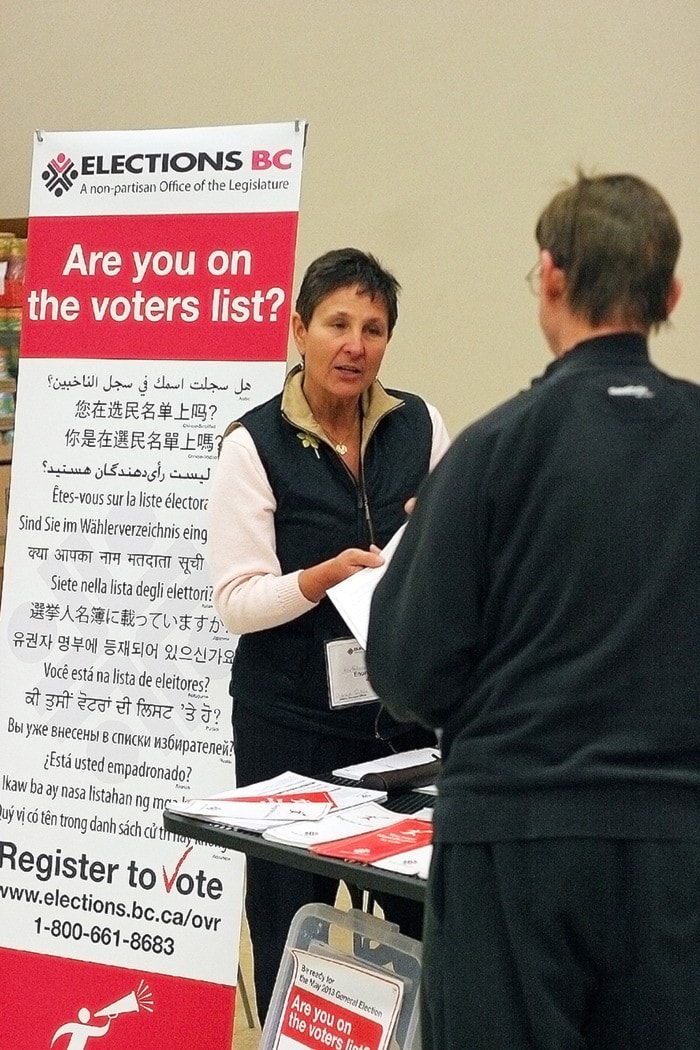In the last provincial election, just over half the eligible voters in B.C. actually marked a ballot.
The 2009 election represented an all-time low for voter turnout, with roughly 1.7 million B.C. residents who could have voted and didn’t.
This year could be better, if the various campaigns to improve voter turnout have the desired effect.
Locally, the Greater Langley Chamber of Commerce aims to increase turnout in the two Langley ridings by at least five per cent.
The chamber has been staging meet-the-leader events with the various provincial political parties to drum up interest.
Elections BC, the independent agency that supervises the vote, has been conducting an enumeration of voters and updating the voters list.
Over 1.9 million notices were mailed to residential addresses in B.C. asking people to register or update their voter information in time for the May 14 vote.
Elections BC officials also set up voter registration desks at shopping malls, community centres and campuses throughout the province.
They conducted door-to-door visits in what are described as “ high mobility neighbourhoods” and new residential complexes and subdivisions.
During the first part of April, Elections BC officials will be visiting long-term care facilities and homeless shelters in the province to provide voter registration and update services.
People can use online voter registration at https://eregister.electionsbc.gov.bc.ca or by phoning Elections BC toll-free at 1-800-661-8683.
Who can vote:
To vote in the May provincial election, a person has to be registered as a voter, a Canadian citizen, at least 18 years old on election day, live in the electoral district where the election is being held, and lived in B.C. for at least six months before voting day.
Where to vote:
Registered voters should receive a “Where to Vote” card in the mail.
They can also visit www.elections.bc.ca online or phone toll-free 1-800-661-8683.
The voting place will be open between 8 a.m. and 8 p.m., Pacific time.
If you can’t vote on election day, there is an advance poll on the Wednesday, Thursday, Friday, and Saturday of the week before election day.
Information about advance voting sites can be found on the yellow “Where to Vote” card or online.
There are also measures to allow absentee voting by people unable to attend their home location on election day.
To vote by absentee voting, visit the voting place that is most convenient for you.
If it happens to be in the same electoral district where you live, you will vote with an ordinary ballot.
If it isn’t the same district, a write-in ballot is used that has a blank space instead of candidate names and you write the name of your preferred candidate or registered political party on the ballot.
And there are options available to people who expect to be out of the province on voting day, or have a physical disability, illness, or injury which prevents them from visiting a voting place, or simply can’t get to a voting place for reasons out of their control, like bad weather.
The District Electoral Officer also has the discretion to send a mobile voting team for eligible voters who are in hospital, a mental health facility, a long-term care facility, a remote work site or a correctional centre.
A legal right to vote:
Under Section 74 of the Election Act a person is entitled to four consecutive hours off from work between 8 a.m. and 8 p.m. on voting day if they are an eligible voter.
It is up to your employer to decide when during the day you can take this time off, but they are not allowed to deduct pay or penalize you for taking the time.
There is an exception, however — a person is not entitled to take time off if their place of work is so remote that it would be unreasonable to try and reach a voting place during voting hours. Violating section 74 could see an employer fined up to $10,000 or jailed up to one year, or both. Alleged violations of the Act should be reported in writing to the Chief Electoral Officer.
Voter ID:
By law, voters must prove their identity and residential address in order to receive a ballot or register to vote.
Acceptable types of identification and information are documents issued by the Government of B.C. or Canada that contain the voter’s name, photograph and residential address, like as a B.C. driver’s licence, B.C. Identification Card (BCID), B.C. Services Card, a Certificate of Indian Status, or two documents that contain the voter’s name.
At least one of the documents must also contain the voter’s residential address.
Other acceptable government-issued identity documents include a healthcare card, birth certificate, Social Insurance Card, passport, citizenship document/certificate, Old Age Security identification card, Canadian Forces identification, firearm acquisition certificate, firearm possession and acquisition licence, Veterans Affairs Canada health care identification card or Correctional Service Canada offender identification card.
A vote may also use a property tax assessment, income tax assessment notice, government cheque, government cheque stub, statement of employment insurance benefits paid, Canada Child Tax benefit statement, statement of Canada Pension Plan benefits and a statement of Old Age Security.
Some school, college or university-issued documents can be used such as an admissions letter, report card, transcript, residence acceptance, tuition/fees statement or student card.
A voter may also present a Provincial Where to Vote card, bank credit card or statement, residential lease or mortgage statement, insurance statement, public transportation pass, utility bill, membership card, hospital bracelet or document or personal cheque.
Someone who has none of the above can be vouched for by a voter in their electoral district who does have the necessary ID, a direct family member or someone with legal authority to make personal care decisions for the voter.
